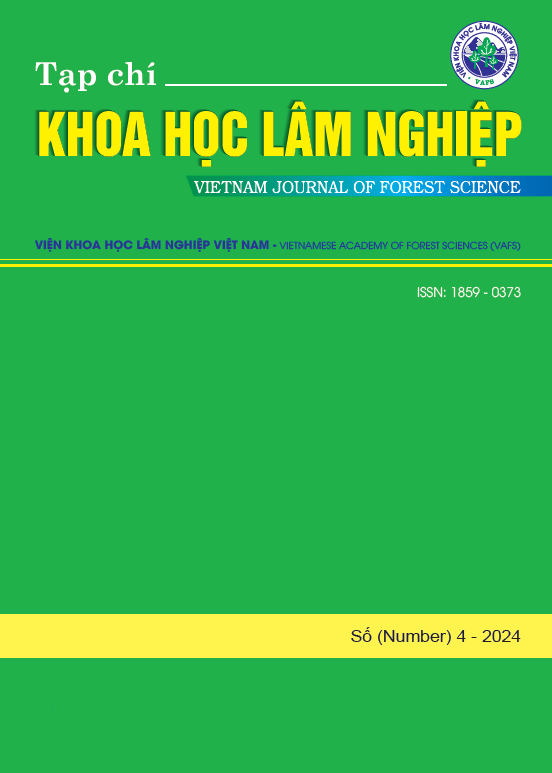GROWTH CAPACITY AND CONTENT OF SOME MEDICINAL CONSTITUTENTS OF Anoectochilus species BY INTENSIVE CULTIVATION UNDER NATURAL FOREST CANOPY AND COVERED ROOF IN TAN UYEN DISTRICT, LAI CHAU PROVINCE
DOI:
https://doi.org/10.70169/VJFS.968Keywords:
Anoectochilus species, growth, flavonoid, polysaccharide, Tan Uyen, Lai ChauAbstract
Results on evaluating the growth ability and content of medicinal constitutents of three species of the genus Anoectochilus Blume, including: A. lanceolatus Lindl, A. calcareus Aver, A. setaceus Blume and tissue cultural plant of A. setaceus species grown under natural forest canopy and covered roof after 16 months of planting in Ho Mit commune, Tan Uyen district, Lai Chau province show that plants grown under forest canopy had survival rate (87.5 - 93.5%), growth indicators (stem diameter 2.96 - 3.38 mm; top height 7.56 - 11.08 cm; 3.67 - 4.34 leaves/plant; 3.61 - 6.23 nodes/stem) and medicinal quality (total flavonoid content 3.37 - 4.95%; total polysaccharide content 5.27 - 7, 18%) higher than plants grown under covered roof (corresponding to 85.0 - 90.4%; 2.89 - 3.33 mm; 8.61 - 17.36%; 3.73 - 4.08 leaves/plant; 4.01 - 6.15 nodes/stem). Three Anoectochilus species had good quality and highly resistant to pests and diseases. The content (%) of total flavonoids and total polysaccharides of three Anoectochilus species grown in intensive models under the natural forest anopy and under the covered roof (total flavonoid content 3.21 - 4.95% and total polysaccharide content 4.38 - 4.89%) did not have a large difference compared to Anoectochilus species distributed in nature (corresponding to 2.89 - 3.73% and 3.32 - 6.26%, respectively), partly due to the accumulation of nutrients of the species grown under different growing conditions. The main medicinal quality of three Anoectochilus species (total flavonoid content 3.21 - 4.95% and total polysaccharide content 4.38 - 4.89%) were higher than that with Anoectochilus species are distributed in the natural forests (corresponding to 2.89 - 3.73% and 3.32 - 6.26%), partly it may be due to nutrient accumulation by planted species. A. lanceolatus species had the highest survival and growth rate, but the medicinal quality was lower than that of A. calcareus Aver, A. setaceus Blume and tissue cultural plant of A. setaceus species. Three planted Anoectochilus species had the good ability in growth, high medicinal quality that are suitable for the climate and soil conditions in Ho Mit commune, Tan Uyen district, Lai Chau province and can be expanded in in the production.









